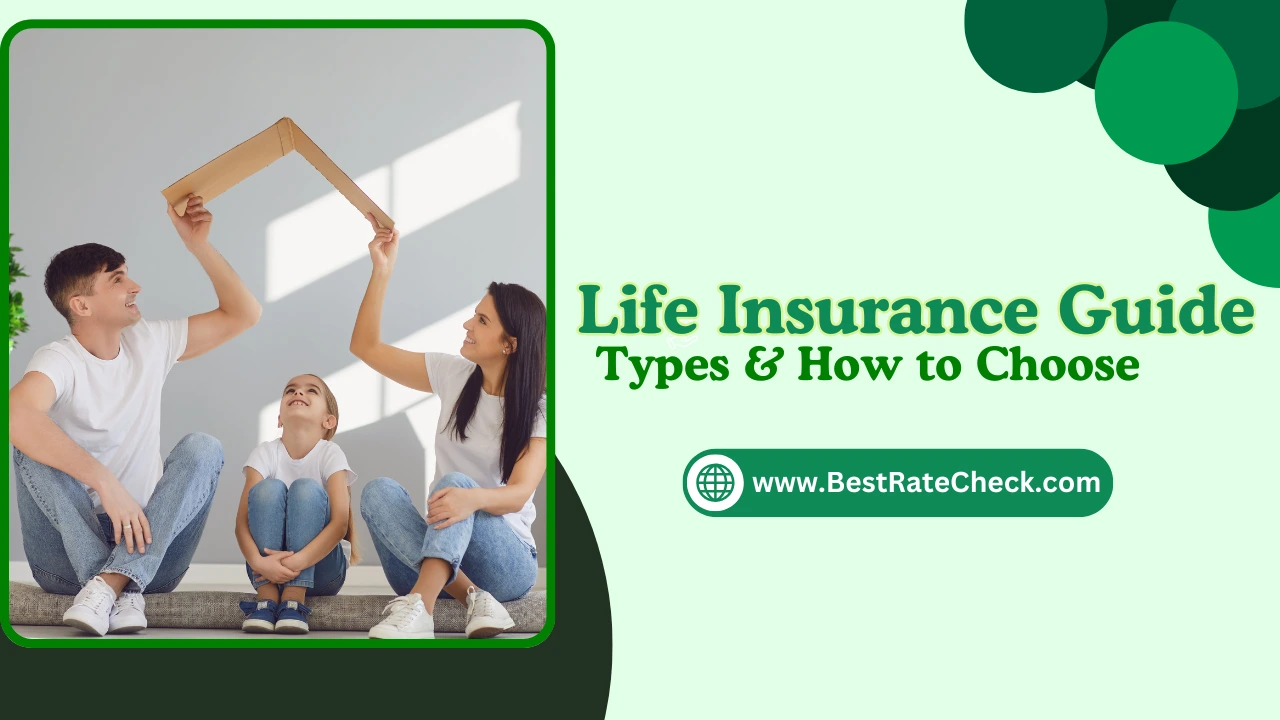Life is unpredictable, but your family’s financial future doesn't have to be. If you pass away unexpectedly, there’s a chance your dependents will struggle with everyday expenses (like rent and utilities), debt, mortgage, or funeral costs.
Life insurance is one way of securing that safety net for your loved ones—a way of making sure they have something to lean on after you’re no more. While you might already have plenty of savings, the extra surplus can buy your family more time to get back on their feet after the loss.
According to Bankrate, nearly 50% of U.S. adults either don’t have a life insurance policy or they’re underinsured. The two scenarios of when you do get insured and when you don’t look very different. Let’s understand both of them so you can make an informed choice.
What is Life Insurance & How Does It Work?
Life insurance is a type of insurance policy that helps provide financial stability to your family after you pass away. You are supposed to pay a regular amount to an insurance company called “premium”. And, if something happens to you, the company will pay a large sum of money (payout/death benefit) to your family or whoever you’ve chosen as the beneficiary.
There are many different types of life insurance policies, but they are grouped into two broad categories: term life (gives temporary coverage) and whole life (has permanent coverage). Before we move on to understanding each of them in detail, find out if you even need one.
Do I Need Life Insurance? Is It Worth It?
Whether you need life insurance or not depends on your situation. Generally, it is best to get insured if you have family members who depend on you for even the most basic expenses. Dependents include your spouse, ageing parents, children, etc., who don’t earn by themselves.
If they rely on your income for everyday expenses like food, rent, and utility bills, they’ll be left with nowhere to turn to after you’re gone. Got ongoing debt like car loans, student loans, mortgages, credit card bills, or loans? That adds additional expenses for your family to pay off.
Also, the average cost for a funeral in the USA is $8,300, according to the National Funeral Directors Association (NFDA). If you don’t have enough savings or assets that can cover at least 6 months of living expenses for your partner or family, getting life insurance may be worth it.
When Is Taking Life Insurance Optional?
For young, single, debt-free individuals with no financial responsibilities, life insurance becomes non-essential, and it is completely optional for them.
Alternatively, suppose you have enough income, savings, and assets to comfortably support yourself and your family in case something happens to you. In that case, it’s okay not to get a life insurance policy. Still, to avoid any risks, you may seek a financial advisor to decide on this.
Seniors who are close to retirement age and do not have a spouse or children to care for them after their death can also consider opting out of insurance policies.
However, the fact that term life insurance is affordable and often comes with lower payments is something to note. Even if you do get insured, it is not going to hurt your finances significantly. Ultimately, you know your situation best, so it is justified to make choices based on that.
How Much Does Life Insurance Cost?
There is no set cost for life insurance, and it varies based on the type of policy, coverage amount, and the company from which you get it. Generally, younger and healthier people need to pay less.
The average monthly cost for life insurance is $26, and the average annual premium for each U.S. household is $993. Some factors that affect the cost of insurance are:
- Age: The younger you are, the less you have to pay.
- Gender: Women tend to live longer, so they pay less.
- Tobacco use: People who smoke have to pay more.
- Health history: If there is a history of health issues, insurance costs more.
- Coverage amount: The more coverage you have, the more premium it is.
- Policy type: Whole-life policies have “cash value,” which reduces total cost over time.
- Term length: The longer the term is, the more you need to pay.
We’ll discuss these factors in detail below. However, one key thing to note here is that the cost of getting life insurance increases as you age. It is therefore advised that you get one when you are younger.
How Much Life Insurance Do I Need?
The amount of life insurance you need depends on your financial situation, family circumstances, and goals related to your lifestyle. As a common rule of thumb, it is best to buy an insurance policy that has a payout of 8 to 10 times your annual salary.
First, consider your current income and how it might grow over time. Other things to consider are your spouse’s income, the age of your children (do you have to plan more for their education and future?), inflation in coming years, your owned assets, funeral costs, etc.
If you need some help sorting through everything, you can use a life insurance calculator. It uses the DIME method—the amount of debt, income, mortgage, and education expenses are used to calculate how much life insurance you need.
Does Life Insurance Cover Suicidal Death?
Most traditional life insurance policies include various causes of death and approve payouts in those situations. However, there is usually a suicide clause that mentions the right to withhold the benefits if the policyholder commits suicide within 2 years of getting the policy.
Suppose the individual insured is found to have been involved in dangerous acts, addiction, drug abuse, serving in the military at the time of death, or already had underlying mental health issues. In that case, the insurance company might deny or reduce the death benefits.
But again, it depends on the policy itself because some companies—if you tell them early on about an addiction or substance abuse—do provide a payout at the time of your death. As a best practice, you should read all the clauses carefully to stay in the know.

Types of Life Insurance & Their Benefits
There are various types of life insurance, and all of them are designed to meet different needs. Term life insurance, whole life insurance, universal life insurance, variable life insurance, and final expense are some of them. Let's compare the main ones so you can make an informed decision.
What is Term Life Insurance?
Term life insurance is a policy that offers coverage for a set period. Usually, you can get it for a term of 10 to 30 years. In case the insured person dies during this term, death benefits are paid to the beneficiaries. You’re supposed to pay a set premium each year for the term’s duration.
You can also choose to receive the payouts in either a lump sum or fixed monthly installments. These benefits can then be used for almost all expenses and help with the loss of income to the insured person’s family members. People find it affordable compared to whole life insurance, it is affordable.
If you’re raising children or paying off your mortgage, it might be a good idea to choose this option. However, if you don’t die during the term and your coverage expires, you need to renew your policy or get a new one. You’re not entitled to get refunds of your premiums when the policy falls off.
What is Whole Life Insurance?
Whole life insurance is permanent insurance that offers coverage throughout the policyholder's life. While you do get a death benefit, there is also cash value (like a savings account), which can be accessed while you’re still alive. When you pay premiums, the amount is divided partly by the cash value and partly by the payout.
The sum that goes towards the cash value is used to invest in bonds, stocks, index funds, and other investment instruments. Depending on the type of policy, how your cash value is invested will differ. This money grows tax-deferred over time, and taxes are charged only when you take it out.
You can even use the cash value to pay for your premiums once it grows. This helps reduce the overall cost of your policy. You can also take out a portion of the cash value, and if the amount is under the limits, there are no tax deductions. The money can be used for retirement, healthcare, or other such expenses. If you take out all the cash value, you won’t get death benefits.
The insured individual can also use the cash value to borrow a loan against it, which can be repaid at a set interest rate. If the loan is not paid off, the owed amount is deducted at the time of the payout. If interest accumulates significantly, the policy collapses, leading to no death benefits.
Here’s how cash value works:
| Action | Cash Value | Impact on Death Benefit | Tax Consequences | Policy Status |
| Partial Withdrawal | Decreases | May reduce | Tax-free up to the amount of premiums paid (cost basis); taxed as income beyond that | Stays Active |
| Full Surrender | Entire amount withdrawn | No benefits (policy terminates) | Amount above cost basis taxed as ordinary income | Policy is canceled |
| Loan Against Cash Value | Decreases (but still earns interest) | Unpaid loan + interest deducted from death benefit | Tax-free unless policy lapses with an unpaid loan | Stays Active |
What is Universal Life Insurance?
Universal life insurance is also a permanent coverage policy, which covers you for your entire life as long as you keep paying for it. It is more flexible than other insurance types because:
- You choose how much to pay in premiums
- Your cash value is invested in a stock market index (e.g., S&P 500)
- The death benefits paid to beneficiaries are tax-free
- You can increase or decrease the payouts as per your financial situation
While you can decide and change the terms, it is slightly harder to manage ULs than a whole life insurance policy. If you’re not careful about keeping the minimum cash value required or premiums, the policy can lapse, nulling out all your death benefits.
What is Variable Life Insurance?
Variable life insurance is a permanent coverage option that also gives you the choice to invest in securities. Based on the performance of your investments, the policy’s cash value, as well as death benefits, will vary. The best part is that you get to choose how and where the cash value is invested.
You can also choose to increase or decrease your benefits. A few downsides are that your cash value might not be tax-free, and you, as the policyholder, are taking the investment risk.
Sometimes, you may lose money. However, there is a short “look period” within which you can cancel your policy without any charge. This time frame varies depending on the insurance provider.
What is Final Expense Insurance?
Final expense insurance, also known as burial or funeral insurance, is a small coverage that helps the insured’s family with end-of-life expenses. This can include covering or aiding with the following costs:
- Funeral
- Medical Bills
- Legal Fees
- Hospice Care
- Cremation
- Memorial Service
- Mortgage Payoffs
- Auto Loans
While the death benefits are smaller, funeral insurance is a great way to make sure that the final arrangements are taken care of after you die. There are often no health checks, which makes it easier to get. If you or your parents have crossed 50, it may be a good time to get it.
What is Supplemental Life Insurance?
Supplemental life insurance is a special type of supplement to your existing coverage that can help with additional costs not covered by traditional policies.
It is a way to strengthen your life insurance and its benefits. Usually, nonmedical expenses, as well as costs for vision, dental, disability, long-term care, and medicare plans, are available under this.
Term vs. Permanent Life Insurance
These are the differences between whole life and term life insurance:
| Feature | Term Life Insurance | Whole Life Insurance |
| Coverage Length | Temporary (usually 10, 20, or 30 years) | Lifetime (as long as premiums are paid) |
| Cost | Affordable | More expensive |
| Payout (Death Benefit) | Pays out only if you die within the term | Guaranteed payout whenever you pass away |
| Cash Value (Savings Feature) | No savings, just insurance | Builds cash value you can borrow or withdraw from |
| Premiums (Payments) | Fixed for the term but may increase if renewed | Fixed for life (more predictable) |
| Best For | Term life insurance rates are often budget-friendly(e.g., while raising kids and paying a mortgage) | Lifetime coverage plus a savings feature for wealth-building |
Whole Life Insurance Rates by Age Chart
While the actual rates can vary based on factors like health and smoking history, etc., here are the average whole life insurance rates by age chart for a $500,000 coverage:
To get affordable life insurance for young adults, seniors, and children, you can compare the best rates before choosing your policy.
Average Term Life Insurance Rates
If you want to get a rough idea of the average term life insurance quotes for a $500,000 coverage through 20 years, here’s a chart to help with it:
Taxation & Life Insurance
The death benefits that your loved ones receive after your demise are generally not taxable. The government doesn’t charge income tax on it, and all proceeds are given to the beneficiaries.
As for the cash value, it keeps growing at a fixed interest in whole life or universal life policies. Each year, any gains that are made aren’t taxed. You may withdraw funds from this value up to the amount you have paid in the premiums (your “cost basis”). If you take out anything above this amount from the cash value, the additional gains are subject to income tax.
The payments you make for the premium of your life insurance aren’t deducted from your income tax.
To Wrap Up: Should You Get Insured?
Life insurance is one way to leave behind an inheritance in the form of liquid funds when you pass away. Whether you should get it or not completely depends on your situation, financial goals, and responsibilities. To figure this out, you can ask yourself the following questions.
- Who would be financially affected if I passed away?
- Do I have debts that would fall on someone else?
- Do I want to leave a financial safety net for my family?
If the answer to the last question is yes, you should definitely consider getting a good life insurance policy. It is best to compare life insurance rates with Best Rate Check first to make sure it’s overall profitable.
Frequently Asked Questions
Every person should take life insurance, preferably “whole life,” because compared to the premiums, you’ll get significant returns. Your family can depend on that money for financial security, and the cash value in your policy can help with emergency expenses while you’re living.
This is a very subjective question and has a subjective answer. If you’re the only earning member in your family, have debts, want to cover funeral costs, or are a stay-at-home parent, life insurance is not a waste of money—it is a great financial investment. However, if you’re single or have enough assets, it might be a waste.
If you’re currently in a bad financial situation, getting life insurance can wait until you’re stable on your feet. Use the money to build savings, and when you feel like you have enough money to go towards investments, you can get insured.
Select My Policy is a platform that allows you to compare life insurance rates before settling on affordable premiums and favorable payouts.
Whether to get a 20 or 30-year term life insurance depends on several factors, but the most important one is your age. If you’ve crossed 50, getting insured for the next 20 years might be a better deal. Similarly, if you’re still young, either opt for whole life insurance or choose longer-term life insurance.
If your life insurance expires before you die, you’re not obligated to receive the death benefits. However, if your policy is renewable, you can do so by contacting the insurance company.
There is no specific age to stop buying term life insurance. It all depends on your specific circumstances.
This is a personal choice, but it is better to get life insurance first if you have dependents who rely on you for living expenses.
There is no “right time” for someone to get insured. However, the earlier you get it, the less premium you’ll be paying since younger people are charged less.



